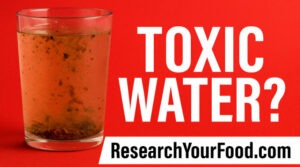You drink it every day. You cook with it. You bathe your children in it. But what if your drinking water is quietly damaging your health? From invisible toxins to chemicals you’ve never heard of, your tap water may be hiding more than just H₂O.

Introduction
Clean drinking water is essential for life—but what if the water you trust most is hiding silent dangers?
Tap and even bottled water may seem safe, but many hidden contaminants can pose serious long-term health risks. From toxic chemicals to microscopic plastics, here’s what you need to know to protect yourself and your family.
The Illusion of “Clean” Water
Most people assume their water is safe simply because it meets local regulations. But what if those standards don’t go far enough?
Aging pipes, industrial pollution, and farm runoff can all contaminate water supplies. Even if your water looks and tastes fine, it might still carry toxins that slowly build up in your body.
The Silent Killer: PFAS – “Forever Chemicals” in Your Water
PFAS (Per- and polyfluoroalkyl substances) are used in non-stick cookware, waterproof clothing, and fast-food packaging.
✅ They don’t break down in the environment—ever.
✅ They have been linked to cancer, hormone disruption, and immune suppression.
Even at low levels, these “forever chemicals” accumulate in your bloodstream over time. That means even small, daily exposures can lead to serious health issues.
Question: Have you checked if your city’s water has been tested for PFAS?
Heavy Metals—The Hidden Threat in Your Pipes
🧪 Lead, arsenic, and mercury are common contaminants in drinking water, especially in older homes.
- Lead can leach from outdated pipes and fixtures, especially in schools and aging neighborhoods.
- Long-term exposure is linked to brain damage, learning delays in children, and heart problems.
- Arsenic—a natural contaminant in some regions—can cause skin lesions, organ damage, and cancer.
Even trace amounts can be dangerous over time.
Microbial Contaminated Water
Not all threats are chemical—some are alive.
Bacteria like E. coli, and parasites like Giardia and Cryptosporidium, can get into water supplies through broken pipes, sewer leaks, or poor sanitation.
🦠 These microbes can cause:
- Severe diarrhea
- Dehydration
- Life-threatening illness in children, seniors, and people with weak immune systems
And here’s a twist: chlorine, often used to disinfect water, can create harmful byproducts like THMs (trihalomethanes), which are linked to cancer. (FACT CHECK ✅)
Nitrates—The Invisible Danger from Farm Runoff
Nitrates seep into groundwater from fertilizers and animal waste. They’re especially dangerous in rural and agricultural areas.
⚠️ For babies, high nitrate levels can cause “blue baby syndrome,” a life-threatening condition that limits oxygen in the blood.
⚠️ Long-term exposure in adults is linked to cancer, thyroid issues, and reproductive problems.
Standard water treatments often fail to remove nitrates.
Microplastics – Yes, You’re Drinking Plastic
Plastic bottles, clothes, packaging, and even car tires shed microplastics—tiny plastic fragments less than 5mm. These particles now show up in tap water, bottled water, and even rain.
🏴☠️ Health concerns include:
- Hormone disruption
- Chronic inflammation
- Build-up in organs and tissues
And guess what? Plastic doesn’t break down. It builds up—inside you.
Pharmaceuticals in Your Water – The Meds You Never Took
Studies have found traces of:
💊 Antibiotics
💊 Hormones
💊 Antidepressants
…in drinking water due to urine excretion, improper drug disposal, and outdated filtration systems.
Even in tiny amounts, these can disrupt hormones, contribute to antibiotic resistance, and affect long-term health.
Most treatment plants aren’t equipped to remove pharmaceutical residues.
Conclusion
Your water may look clean—but what’s lurking inside could be silently harming your health.
From PFAS and heavy metals to microplastics and pharmaceuticals, drinking water contamination is real—and it’s growing.
✅ Invest in a high-quality water filter (one that removes PFAS, heavy metals, and pathogens).
✅ Check your local water report annually.
✅ Push for better infrastructure and updated water standards.
Clean water isn’t a luxury—it’s your right. But awareness is your first line of defense.
Question: Do you filter your drinking water? What kind of system do you use?
References
- https://www.sciencedirect.com/science/article/pii/S1674237023000522
- https://www.who.int/publications/i/item/9789241516198
- https://pmc.ncbi.nlm.nih.gov/articles/PMC1392223/
- https://pmc.ncbi.nlm.nih.gov/articles/PMC11163811/
- https://www.pa.gov/content/dam/copapwp-pagov/en/health/documents/topics/documents/environmental-health/PFAS%20Fact%20Sheet.pdf
- https://pmc.ncbi.nlm.nih.gov/articles/PMC2944108/
Leave a Reply